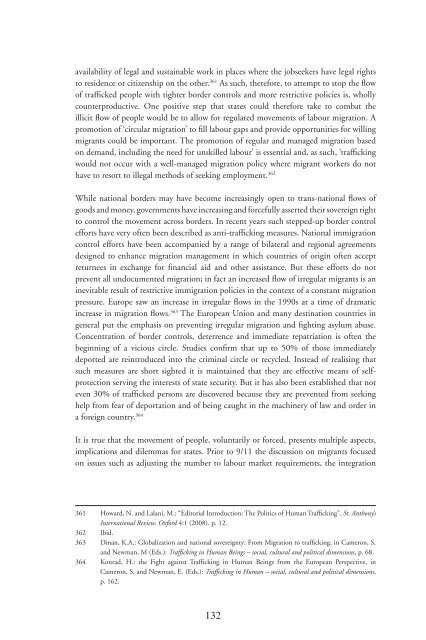Trafficking in human beings: human rights and ... - unesdoc - Unesco
Trafficking in human beings: human rights and ... - unesdoc - Unesco
Trafficking in human beings: human rights and ... - unesdoc - Unesco
Create successful ePaper yourself
Turn your PDF publications into a flip-book with our unique Google optimized e-Paper software.
availability of legal <strong>and</strong> susta<strong>in</strong>able work <strong>in</strong> places where the jobseekers have legal <strong>rights</strong><br />
to residence or citizenship on the other. 361 As such, therefore, to attempt to stop the fl ow<br />
of traffi cked people with tighter border controls <strong>and</strong> more restrictive policies is, wholly<br />
counterproductive. One positive step that states could therefore take to combat the<br />
illicit fl ow of people would be to allow for regulated movements of labour migration. A<br />
promotion of ‘circular migration’ to fi ll labour gaps <strong>and</strong> provide opportunities for will<strong>in</strong>g<br />
migrants could be important. The promotion of regular <strong>and</strong> managed migration based<br />
on dem<strong>and</strong>, <strong>in</strong>clud<strong>in</strong>g the need for unskilled labour’ is essential <strong>and</strong>, as such, ‘traffi ck<strong>in</strong>g<br />
would not occur with a well-managed migration policy where migrant workers do not<br />
have to resort to illegal methods of seek<strong>in</strong>g employment. 362<br />
While national borders may have become <strong>in</strong>creas<strong>in</strong>gly open to trans-national fl ows of<br />
goods <strong>and</strong> money, governments have <strong>in</strong>creas<strong>in</strong>g <strong>and</strong> forcefully asserted their sovereign right<br />
to control the movement across borders. In recent years such stepped-up border control<br />
efforts have very often been described as anti-traffi ck<strong>in</strong>g measures. National immigration<br />
control efforts have been accompanied by a range of bilateral <strong>and</strong> regional agreements<br />
designed to enhance migration management <strong>in</strong> which countries of orig<strong>in</strong> often accept<br />
returnees <strong>in</strong> exchange for fi nancial aid <strong>and</strong> other assistance. But these efforts do not<br />
prevent all undocumented migration; <strong>in</strong> fact an <strong>in</strong>creased fl ow of irregular migrants is an<br />
<strong>in</strong>evitable result of restrictive immigration policies <strong>in</strong> the context of a constant migration<br />
pressure. Europe saw an <strong>in</strong>crease <strong>in</strong> irregular fl ows <strong>in</strong> the 1990s at a time of dramatic<br />
<strong>in</strong>crease <strong>in</strong> migration fl ows. 363 The European Union <strong>and</strong> many dest<strong>in</strong>ation countries <strong>in</strong><br />
general put the emphasis on prevent<strong>in</strong>g irregular migration <strong>and</strong> fi ght<strong>in</strong>g asylum abuse.<br />
Concentration of border controls, deterrence <strong>and</strong> immediate repatriation is often the<br />
beg<strong>in</strong>n<strong>in</strong>g of a vicious circle. Studies confi rm that up to 50% of those immediately<br />
deported are re<strong>in</strong>troduced <strong>in</strong>to the crim<strong>in</strong>al circle or recycled. Instead of realis<strong>in</strong>g that<br />
such measures are short sighted it is ma<strong>in</strong>ta<strong>in</strong>ed that they are effective means of selfprotection<br />
serv<strong>in</strong>g the <strong>in</strong>terests of state security. But it has also been established that not<br />
even 30% of traffi cked persons are discovered because they are prevented from seek<strong>in</strong>g<br />
help from fear of deportation <strong>and</strong> of be<strong>in</strong>g caught <strong>in</strong> the mach<strong>in</strong>ery of law <strong>and</strong> order <strong>in</strong><br />
a foreign country. 364<br />
It is true that the movement of people, voluntarily or forced, presents multiple aspects,<br />
implications <strong>and</strong> dilemmas for states. Prior to 9/11 the discussion on migrants focused<br />
on issues such as adjust<strong>in</strong>g the number to labour market requirements, the <strong>in</strong>tegration<br />
361 Howard, N. <strong>and</strong> Lalani, M.: “Editorial Introduction: The Politics of Human Traffi ck<strong>in</strong>g”. St. Anthony’s<br />
International Review. Oxford 4:1 (2008). p. 12.<br />
362 Ibid.<br />
363 D<strong>in</strong>an, K.A.: Globalization <strong>and</strong> national sovereignty: From Migration to traffi ck<strong>in</strong>g, <strong>in</strong> Cameron, S.<br />
<strong>and</strong> Newman, M (Eds.): Traffi ck<strong>in</strong>g <strong>in</strong> Human Be<strong>in</strong>gs – social, cultural <strong>and</strong> political dimensions, p. 68.<br />
364 Konrad, H.: the Fight aga<strong>in</strong>st Traffi ck<strong>in</strong>g <strong>in</strong> Human Be<strong>in</strong>gs from the European Perspective, <strong>in</strong><br />
Cameron, S. <strong>and</strong> Newman, E. (Eds.): Traffi ck<strong>in</strong>g <strong>in</strong> Human – social, cultural <strong>and</strong> political dimensions,<br />
p. 162.<br />
132

















